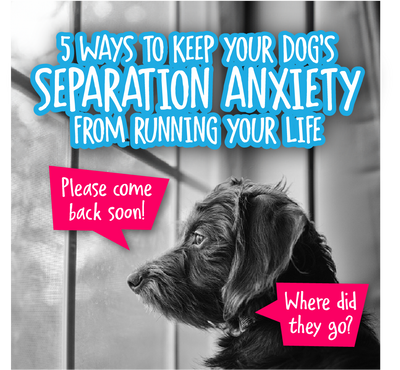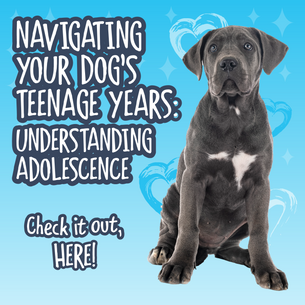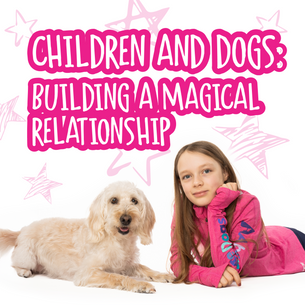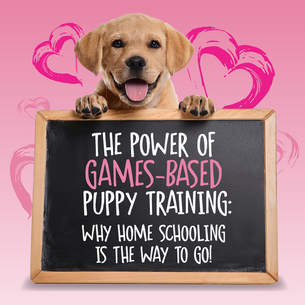Are you struggling with your dog's separation anxiety? Do you feel like it’s literally running your life - dictating what you can do, when you can do it, how long you can do it for and who you can do it with?
Living with a dog who finds it hard to spend any time home alone—or struggles to be separated from you when you’re in the house—can be extremely challenging.
As well as being an ordeal for your dog, it can leave you feeling trapped. From destructive behaviours to incessant barking, the symptoms of separation anxiety can wreak havoc on your household. But fear not! While there is a very common misconception that separation anxiety is something you simply have to manage rather than cure, in reality, it’s more often than not simply a case of knowing what to do, how to do it, and—most importantly—understanding it from your dog's perspective. In this blog, we'll explore five effective strategies to help you teach your dog that spending periods of time alone is actually a good deal and reclaim peace of mind in your home.
Recognising the Signs of Separation Anxiety
It's essential to recognise the signs of separation anxiety in order to address the issue effectively and alleviate your dog’s distress.
Does your dog become visibly worried when you prepare to leave? Do they exhibit destructive behaviours in your absence, such as chewing furniture or scratching doors? Do they bark or howl while you’re out, pace and struggle to settle, and find it impossible to eat or drink in your absence?
These are classic signs of separation anxiety. Setting up a camera and watching what happens in the first 10 minutes of your absence is a brilliant way to know for sure how your dog responds when you go out.
Now, ask yourself this: what about when you’re at home? Can your dog relax away from you, or do they follow you around the house? Can you go to the bathroom in peace?
Maybe your dog is brilliant at relaxing away from you on their own terms, but they struggle as soon as that separation is enforced—by a closed door, a puppy pen, or another physical barrier.
In either case, your dog doesn’t currently have the skills to be able to relax independently, away from you, and see this as a good deal.
OK, so how do you teach those skills? What key pieces of learning does your dog need in order to stay calm and relaxed when you’re at home—and when you leave?
Understanding Separation Anxiety
Separation anxiety is more than just a case of FOMO when you go out. Dogs are social animals. They don't come knowing that being left alone for periods of time is a good deal! While some embrace this fairly easily, for others it’s a real struggle. In fact, for some dogs, it is truly terrifying. Not every dog naturally wants to spend time alone—or has the skills to be able to do so.
And there’s the key. It’s all about your dog’s skills and their understanding of the world. What’s a good deal? What skills does your dog need to grow in order to be able to relax independently, and be totally cool about it? Because if your dog can’t relax when you’re at home, there is no way they are going to be able to chill out and relax when you’re not!
By understanding the root causes of separation anxiety, you can better address your dog's needs and provide the support they require. And it all starts without even leaving the house.
Strategy 1: Consider How You Feed Your Dog
When it comes to separation anxiety, thinking about how your dog eats is so important.
Here at Absolute Dogs we love to Ditch the Bowl and put our dogs’ daily food to use in purposeful ways - and having some of that food set aside for rewarding and reinforcing all the skills and brilliant choices that will set your dog up for the very best separation success is pure training gold.
Putting value into calm settled behaviour with long lasting chews, Calm Mats and enriching stuffables is just one way you can help your dog embrace alone time and see it as a really good deal. Pair this with Presence Doesn’t Mean Access and Boundary Games for maximum impact.
And of course it’s worth giving a thought to your dog’s gut wellness and brain health alongside any training plan. Did you know that research consistently highlights the profound impact of gut health on behaviour - for humans and dogs?
Incorporating natural supplements such as A-OK9’s Calm-K9 and Probio-K9 is one simple and effective choice you can make to help keep your dog’s brain and gut wellness in perfect balance. Their key ingredients are designed to impact the gut and in turn the brain, supporting your dog’s training and behaviour transformation - perfect for dogs who tend towards anxious behaviours and need some extra support.
Strategy 2: Teach Presence Doesn’t Mean Access
This is absolutely vital for making inroads in helping any dog with separation anxiety.
If your dog has constant access to you whenever you’re at home, they learn that your presence is important. It’s part of their blueprint of the world. And of course, if your presence is important, then so is your absence.
Teaching your dog that it’s actually a really good deal to spend periods of the day - every day - separated from you by a physical barrier - will make the transition to going out of the house so much easier.
You can help your dog to learn this important concept by using what we call a “gated community”. Baby gates, puppy pens, closed doors and crates are all options here.
When working on your dog's ability to settle calmly away from you, consider these four variables:
1. Occupied vs. Unoccupied: Dogs often settle more easily with a chew or calm activity. Gradually vary this to avoid dependency on food or calming activities and prevent your dog from associating food with your departure.
2. Distance: Stay close initially, then gradually increase the distance as your dog becomes more comfortable. Our mantra is “Stay close, visit often.”
3. Duration: Start with short sessions and gradually extend the time, ensuring you don’t always make it harder. Easy wins are important too!
4. Visual Access: Some dogs settle better without seeing you, while others need visual contact. Determine what works best for your dog and gradually introduce more challenges as their skills increase.
Strategy 3: Play Boundary Games
Boundary Games teach your dog so many vital, real-life skills - and in the context of separation anxiety one of the most valuable is the ability to relax and settle independently, without following you around.
Ultimately, this will allow you to build the component of distance which is vital for successful presence doesn’t mean access sessions - and for being able to leave your dog home alone.
Incorporating Boundary Games into every aspect of your dog’s life - while you cook, clean, eat dinner and go about your day to day - is the best way to grow their value and build your dog’s skills.
If your dog is new to Boundary Games, download your free copy of our Boundary Games eBook and check out our Real Life Boundaries course for the step-by-step games and strategies to teach your dog to have real-life value for a boundary.
Strategy 4: Help Your Dog Learn to Relax
Helping your dog learn to relax is so important. Dogs who don’t understand how to tune out, switch off and chill out, and who are anxious and vigilant about things happening around them will find it impossible to cope with being left alone.
Encouraging calmness is crucial in managing separation struggles. Before expecting your dog to remain calm when left alone, you need to establish a foundation of calmness in your presence by rewarding calm behaviour choices and playing games that grow this rockstar concept. Your dog’s Ditch the Bowl comes in here too!
Dive into the free Absolute Dogs Calm eBook for top tips and strategies.
Understanding your dog’s stress bucket is also vital. Just like humans, dogs have stress thresholds. Imagine this like a bucket. Your dog’s bucket might be big or small. The hole in the bottom of the bucket which allows it to empty might be big or small too. This bucket represents your dog’s capacity to deal with the events of the day.
For dogs who struggle with separation, this bucket is often very full much of the time. This makes separation anxiety worse and can also be a contributing factor to those struggles - so learning how to manage your dog’s bucket and keep it as empty as possible is so important.
If you think your dog has a full stress bucket - or if you simply want to find out more about how games and lifestyle choices can keep your dog’s bucket in optimum shape, check out Core Learning course - free to our Games Club members - for a deep dive into some really fundamental and foundational learning.
Make sure your dog is getting enough sleep too! It’s not just we humans who can find life more challenging when we’ve not had enough quality sleep. A good night's rest is crucial for your dog’s overall well-being - and is another vital consideration for tackling separation struggles.
Intrigued to dive deeper into this fascinating subject? There’s a podcast episode for that!
Strategy 5: Boost Your Dog’s Skills
As well as having a full stress bucket, your dog might be missing some other key skills that would help them relax in your absence rather than getting worried or stressed being left alone.
This is all about concepts - those building blocks of your dog’s brain, which determine whether they have the skills to handle the situations life presents.
Take optimism, for example. Just like humans, some dogs are born optimists while others are more pessimistic by nature. If your dog has a pessimistic view of the world, anything new, different, or challenging will trigger feelings of fear and uncertainty. This will include being left alone.
By playing games that focus on building and growing optimism, you can make your dog’s outlook more optimistic, and guard against separation struggles.
Read more in the free Absolute Dogs Optimism Rocks eBook.
Tolerance of frustration is another skill that could be impacting your dog’s willingness to embrace time alone. If you find yourself faced with a situation where your dog is actually quite relaxed about you leaving the house, but struggles to be separated from you while you’re at home, it may be their toleration of frustration muscle that needs to be flexed. Tolerance of frustration dictates how well your dog copes when they can’t have immediate access to something they want (toys, food, a dog in the distance, and in the case of separation struggles, YOU!). If you’ve tried to build your dog’s understanding of presence doesn’t mean access and hit this hurdle, you will know exactly what we mean!
Simple, fun effective games like Cardboard Chaos and Noise Box are powerful for helping grow these skills. Join us in Games Club for these and an endless variety of other games you can play with your dog to boost and grow all these vital concepts, and target any training struggle you might encounter.
Conclusion
Dealing with separation anxiety can be challenging, but it's not insurmountable. By understanding the root causes of your dog's anxiety, recognising the signs, not rushing to put them in situations they aren’t ready for, and implementing proactive strategies through positive games-based training, you can help your dog feel more secure and relaxed when you're away.
Remember, every dog is unique, so don't be afraid to experiment until you find what works best for your dog. With patience, persistence, and plenty of love and support, you can help your dog overcome their separation anxiety and thrive in your absence - as well as in your presence!
Want to read more? We have more advice and tips in our blog post Separation Anxiety in Dogs - The Dos and Don’ts.
Free Live Training - Sign Up Now
Working through separation struggles with your own dog, or keen to learn more?
Join us on Thursday 27th June for a free live training event dedicated to separation anxiety.
Register below and we’ll send you more information nearer the time.






